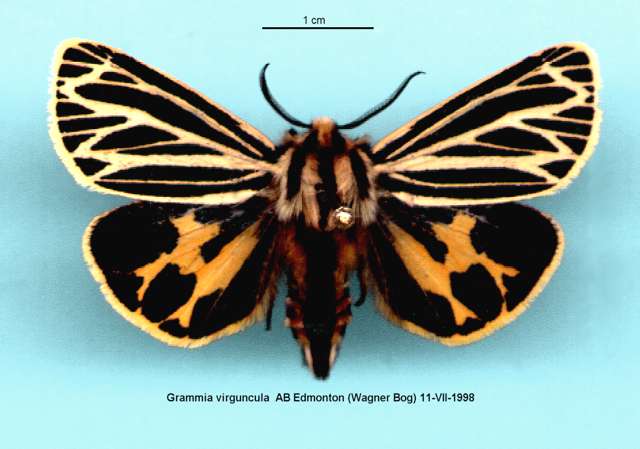Species Details
Grammia speciosa
University of Alberta E.H. Strickland Entomological Museum Read more about this collection »
SeasonalityEarly to mid July.
IdentificationThe hindwing is orange-yellow with varying amounts of black. Similar to G. obliterata, but speciosa has fine white lines along the veins of the forewing and lacks the white transverse bands that is on G. obliterata.
Scientific Name
Grammia speciosa
Habitat
Primarily a boreal forest species, can also be found in bogs and fens.
Seasonality
Early to mid July.
Identification
The hindwing is orange-yellow with varying amounts of black. Similar to G. obliterata, but speciosa has fine white lines along the veins of the forewing and lacks the white transverse bands that is on G. obliterata.
The hindwing is orange-yellow with varying amounts of black. Similar to G. obliterata, but speciosa has fine white lines along the veins of the forewing and lacks the white transverse bands that is on G. obliterata.
Life History
No information available.
Conservation
Locally common in bogs and fens, however it is rare in the prairie grasslands.
Diet Info
Probably a wide variety of forbs. Larvae can be reared on Plantain (Plantago) and dandelion (Taraxacum) (Gibson, 1901).
Range
Yukon to Newfoundland, south to New Jersey and to Colorado and New Mexico in the west.
References
Author
Gibson, A.
Title
The life history of Arctia virguncula Kirby.
Publication Date
1901
Series Title
The Canadian Entomologist
Volume
33
Pages
325-329
Author
Schmidt, B. C.
Title
The tiger moths (Arctiidae) of Alberta.
Publication Date
2000
Pages
36
Specimen Information
There are 26 specimens of this Species.
UASM12582 - Grammia speciosa
University of Alberta E.H. Strickland Entomological Museum
Place CollectedCanada: Alberta, Edmonton
Collected ByBowman, K.
Date Collected1931-07-13
UASM12583 - Grammia speciosa
University of Alberta E.H. Strickland Entomological Museum
Place CollectedCanada: Alberta, Edmonton
Collected ByBowman, K.
Date Collected1918-07-09
UASM12584 - Grammia speciosa
University of Alberta E.H. Strickland Entomological Museum
Place CollectedCanada: Alberta, Edmonton
Collected ByBowman, K.
Date Collected1924-07-25
UASM12599 - Grammia speciosa
University of Alberta E.H. Strickland Entomological Museum
Place CollectedCanada: Alberta, Edmonton
Collected ByBowman, K.
Date Collected1917-07-06
UASM12601 - Grammia speciosa
University of Alberta E.H. Strickland Entomological Museum
Place CollectedCanada: Alberta, Edmonton
Collected ByBowman, K.
Date Collected1916-06-29
UASM12602 - Grammia speciosa
University of Alberta E.H. Strickland Entomological Museum
Place CollectedCanada: Alberta, Edmonton
Collected ByBowman, K.
Date Collected1919-07-05
UASM12608 - Grammia speciosa
University of Alberta E.H. Strickland Entomological Museum
Place CollectedCanada: Alberta, Edmonton
Collected ByBowman, K.
Date Collected1924-07-13
UASM12619 - Grammia speciosa
University of Alberta E.H. Strickland Entomological Museum
Place CollectedCanada: Alberta, Edmonton
Collected ByBowman, K.
Date Collected1941-07-17
UASM12620 - Grammia speciosa
University of Alberta E.H. Strickland Entomological Museum
Place CollectedCanada: Alberta, Edmonton
Collected ByBowman, K.
Date Collected1916-07-07
UASM12622 - Grammia speciosa
University of Alberta E.H. Strickland Entomological Museum
Place CollectedCanada: Alberta, Edmonton
Collected ByBowman, K.
Date Collected1930-07-17
UASM12625 - Grammia speciosa
University of Alberta E.H. Strickland Entomological Museum
Place CollectedCanada: Alberta, Edmonton
Collected ByBowman, K.
Date Collected1924-07-24
UASM12633 - Grammia speciosa
University of Alberta E.H. Strickland Entomological Museum
Place CollectedCanada: Alberta, Cooking Lake
Date Collected1918-07-17
UASM12629 - Grammia speciosa
University of Alberta E.H. Strickland Entomological Museum
Place CollectedCanada: Alberta, Edmonton
Collected ByMackie, Donald
Date Collected1922-07-28
UASM12637 - Grammia speciosa
University of Alberta E.H. Strickland Entomological Museum
Place CollectedCanada: Alberta, Edmonton
Date Collected1917-07-06
UASM12639 - Grammia speciosa
University of Alberta E.H. Strickland Entomological Museum
Place CollectedCanada: Alberta, Edmonton
Date Collected1917-07-06
UASM24082 - Grammia speciosa
University of Alberta E.H. Strickland Entomological Museum
Place CollectedCanada: Alberta, Wainwright Dunes Ecological Reserve
Collected ByAnweiler, G. G.
Date Collected2002-07-13
UASM24083 - Grammia speciosa
University of Alberta E.H. Strickland Entomological Museum
Place CollectedCanada: Alberta, Wainwright Dunes Ecological Reserve
Collected ByAnweiler, G. G.
Date Collected2002-07-13
UASM24098 - Grammia speciosa
University of Alberta E.H. Strickland Entomological Museum
Place CollectedCanada: Alberta, Wainwright Dunes Ecological Reserve
Collected ByAnweiler, G. G.
Date Collected2002-07-13
UASM24634 - Grammia speciosa
University of Alberta E.H. Strickland Entomological Museum
Place CollectedCanada: Alberta, Junction Mountain
Collected ByPike, Edward Marshall
Date Collected2000-08-26
UASM35938 - Grammia speciosa
University of Alberta E.H. Strickland Entomological Museum
Place CollectedCanada: Alberta, Bragg Creek
Collected BySperling, F. A. H.
Date Collected1972-07-12
UASM43154 - Grammia speciosa
University of Alberta E.H. Strickland Entomological Museum
Place CollectedCanada: Alberta, Wagner Natural Area
Collected ByLawrie, D.
Date Collected1998-07-11
